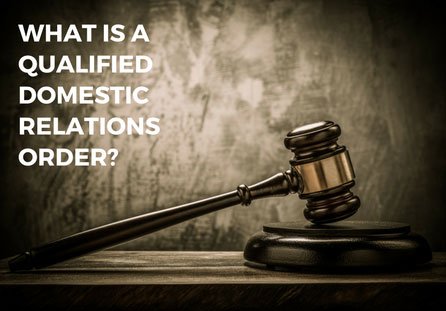
Qualified Domestic Relations Order
The emotional and financial trauma that comes with a divorce is difficult enough for a couple. During the divorce, it is relatively simple to divide tangible assets like homes or vehicles. However, the equitable division of a retirement plan or a pension plan is more difficult.
While many individuals assume their divorce settlement agreement will fully protect their rights to the portion of their former spouse’s retirement fund that was contributed during their marriage, this is not always the case. One way to ensure that your retirement funds are equitably distributed is through a Qualified Domestic Relations Order.
What Is A Qualified Domestic Relations Order (QDRO)?
A Qualified Domestic Relations Order is a court order that divides the benefits of a retirement plan between two former spouses and is then accepted by the administrator of the retirement plan. A Qualified Domestic Order generally contains specific directions for how a retirement fund or pension plan will be distributed between the two former spouses. Administrators of pensions and retirement funds have specific requirements for the division of retirement funds. When the former spouse becomes eligible for retirement, a Qualified Domestic Order will direct the administrator of the retirement account to distribute the funds between the employee and non-employee former spouses according to this legal order.
Typically, a court will issue a Domestic Relations Order which grants a non-employee spouse the right to a certain portion of an employee-spouse’s retirement fund. In addition to a portion of the retirement fund’s annuity benefits, a Domestic Order can also entitle the non-employee spouse to survivor benefits should the employee spouse predecease the non-employee spouse. The Domestic Order becomes a “Qualified Domestic Order” when it is accepted for processing by the administrator of the retirement plan or pension fund.
What Are The Benefits Of A Qualified Domestic Relations Order?
A Qualified Domestic Order has benefits both for the former spouse contributing to the retirement fund and for the former spouse seeking the future retirement benefits. For the spouse contributing to the retirement fund, a QDRO will ensure that retirement fund will be divided only to the extent of the contributions made during the marriage. Further, because a spouse may initiate a court proceeding seeking a Qualified Domestic Order at any time, completing the Qualified Domestic Order during the divorce proceedings can provide finality to the division of assets that is required when a marriage is terminated.
For the former spouse seeking the retirement account’s benefits, a Qualified Domestic Order will provide certainty about the annuity amount he or she can expect during retirement and preserve any rights to ancillary retirement benefits such as survivor benefits and cost of living adjustments. Perhaps more importantly, because a Qualified Domestic Order is essentially a directive from the court to the retirement plan administrator, it allows the person to completely bypass their former spouse when it’s time to collect retirement benefits.
A Qualified Domestic Order will make the fund pay the benefits out directly to the non-employee spouse. While a Qualified Domestic Order can direct a lump sum payment to the non-employee spouse if allowed by the pension plan, most pension funds or retirement funds do not allow this. Therefore, a Qualified Domestic Order more typically involves paying out monthly benefits once the employee-spouse reaches retirement age or the employee-spouse elects to receive retirement benefits.
Why Do I Need A Qualified Domestic Relations Order?
Federal law requires that a retirement benefit can only be divided between two former spouses through a Qualified Domestic Order. Because federal law overrules state law, a divorce decree by a state court mandating a division of retirement benefits may not be enforceable unless it meets the precise requirements of a Qualified Domestic Relations Order.
Through a combination of federal and state laws, a Qualified Domestic Order ensures that the retirement funds will not be penalized or incur tax consequences as a result of the retirement fund’s new directive for distributing the assets.
Do All Retirement Accounts And Pension Funds Qualify For A Qualified Domestic Relations Order?
No. A Qualified Domestic Order is only available for retirement funds and pension plans covered under the Employee Retirement Income Security Act, or more colloquially referred to as “ERISA.” Therefore, a Qualified Domestic Order is only available for the following employer-provided retirement funds and pensions:
A 401(k) plan.
A 403(b) plan.
A 457 plan.
Profit-sharing plans.
Money purchase plans.
Employee Stock ownership plans.
Tax-Sheltered Annuities
A Qualified Domestic Order technically will not apply to retirement funds and pensions provided by the military, federal government, and state/local governments, but similar instruments are available in these situations (“Court Order Acceptable for Processing”, “Retirement Benefits Court Order”, “Order Dividing Military Pay”, etc.). Non-employer retirement plans can be divided without a QDRO through a properly drafted marital settlement agreement.
What Must A Qualified Domestic Order Include?
A Qualified Domestic Relations Order must comply with three general sets of rules. First, the judicial order must comply with the requirements laid out in the Employee Retirement Income Security Act. Second, the order must meet all the requirements in the tax code – which, almost exactly parallel the ERISA requirements.
According to the Department of Labor, a Qualified Domestic Order must include:
The name and last known mailing address of the non-employee spouse and employee spouse
The name of each retirement or pension plan to which the Qualified Domestic Order applies
The dollar amount (or percentage, if applicable) of the benefit to be paid to the non-employee spouse
The number of payments (or the time period, if applicable) in which the order applies
Third, the Qualified Domestic Relations Order must comply with the rules of the retirement or pension fund itself. The Qualified Domestic Relations Order cannot force the retirement fund to distribute funds in a manner inconsistent with the plan’s policies and procedures. In many cases, this can prevent a “lump sum” payment out of the fund at the conclusion of the divorce proceedings.
What Is Typically Included In A Qualified Domestic Relations Order?
A Qualified Domestic Relations Order is a judicial decree that provides instructions for the administrator of a retirement fund or pension, and typically includes the following:
The amount of benefits that will go to the non-employee spouse and employee-spouse.
The time that the benefits will be distributed. Typically, the retirement funds are distributed during the employee-spouse’s normal retirement period. However, a Qualified Domestic Relations Order can sometimes allow a non-employee spouse to receive a lump sum payment or a monthly retirement benefit beginning when the employee spouse reaches retirement age even if the employee spouse elects to defer collecting retirement benefits.
The form that the benefits will be distributed to the non-employee spouse. Again, a Qualified Domestic Relations Order can direct an administrator to pay a lump sum or monthly payments.
When Should I Seek A Qualified Domestic Relations Order?
If a person is seeking a Qualified Domestic Relations Order in order to divide their former spouse’s retirement or pension fund, the best time to petition the court is before the divorce is finalized.
Here a few consequences of waiting to seek a Qualified Domestic Order:
The employee-spouse may retire. Once he or she begins collecting benefits from the retirement fund, it may be difficult if not impossible to retroactively claw back the benefits that the non-employee spouse would otherwise be entitled to receive. At the bare minimum, this could potentially turn into a costly, lengthy legal battle that could easily be avoided.
The employee-spouse may die. If the retirement plan has any pre-retirement death benefits, the non-employee spouse will not be able to receive the benefits.
The employee-spouse may withdraw from the account or take a loan against it. Without a Qualified Domestic Order, the employee-spouse still has complete control over, and unfettered rights, to his or her retirement account. Unfortunately, this means that he or she can also significantly reduce the value of the fund by actually withdrawing his contributions or taking a loan against the account, encumbering the rights of the non-employee spouse.
Waiting to seek a Qualified Domestic Order may result in lost evidence of financial records. Financial institutions typically only keep records for a limited period of time, usually seven years. The longer a non-employee spouse waits to seek a Qualified Domestic Order, the more likely it is that relevant evidence becomes more difficult to locate, which would ultimately harm the non-employee spouse’s ability to seek maximum contribution from the retirement or pension fund.
What Are The Alternatives To A Qualified Domestic Relations Order?
A Qualified Domestic Order is not the only option available to divorcing couples seeking to divide a retirement fund or pension plan. The divorcing couple may instead choose a “buy-out” agreement. In a “buy-out” agreement, the employee-spouse retains full retirement benefits and instead choosing to pay a certain amount to the non-employee spouse, either as a lump sum or through installment payments. Both spouses must agree to the “buy-out” and their agreement is usually included in the marital separation agreement or the final divorce decree. Because of the possible tax consequences, most divorcing couples choose to avoid this route.
Who Should Prepare The Qualified Domestic Relations Order?
A tax attorney should prepare a Qualified Domestic Order. While a family law attorney may be the obvious choice, the tax consequences of an improperly administered Qualified Domestic Order can be grave. Tax attorney Steve Thienel has the expertise and experience in drafting a Qualified Domestic Order that you need to ensure your retirement assets are properly handled.
You Might Also Be Interested In…
Estate Planning: Top 50 Questions Answered
Estate planning can be an uncomfortable and overwhelming process. It doesn’t have to be. Armed with the information you need, estate planning can be an empowering process that takes a load of stress off of you and your family. Get the answers to the top 50 estate-planning questions from an experienced Maryland estate-planning attorney.












